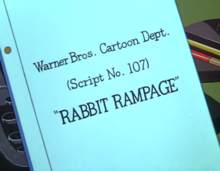Rabbit Rampage
| Rabbit Rampage | |
|---|---|
 | |
| Directed by | Charles M. Jones |
| Story by | Michael Maltese |
| Produced by | Edward Selzer |
| Starring | Mel Blanc |
| Music by | Milt Franklyn |
| Animation by | Ben Washam[1][2] |
| Layouts by | Ernest Nordli |
| Backgrounds by | Philip De Guard[1][3] |
| Color process | Technicolor[1] |
Production company | |
| Distributed by | Warner Bros. Pictures The Vitaphone Corporation[1] |
Release date |
|
Running time | 6:58[2] |
| Language | English |
Rabbit Rampage is a 1955 Warner Bros. Looney Tunes animated cartoon, directed by Chuck Jones.[4] The short was released on June 11, 1955, and stars Bugs Bunny.[5]
Plot
[edit]The short film begins with the animator drawing Bugs Bunny's hole, but abruptly relocates it to the sky, causing Bugs to fall out upon waking up. Bugs does not want to cooperate with the animator and attempts to retreat into his hole, only to find it erased. Frustrated, Bugs confronts the animator, who proceeds to depict Bugs as a coward by painting a yellow streak on his back. Bugs breaks the animator's brush.
Bugs threatens to report the animator to Warner Bros. Studios and accuses him of being a societal menace. The animator retaliates by drawing protest signs in Bugs' hands, provoking further panic from Bugs. After several failed attempts to resist, Bugs begrudgingly agrees to work on the film.
Fed up, Bugs walks away, only to find himself drawn into a forest scene by the animator. Amidst further antics, including anvil-related mishaps and head transformations, Bugs becomes increasingly exasperated. Despite his protests, the animator continues to toy with Bugs' appearance, culminating in Bugs being depicted as a horse.
Asserting his contractual rights, Bugs demands to be drawn as a rabbit. Eventually restored to his original form, Bugs warns the animator of potential consequences. However, the animator's actions escalate, leading Bugs to demand to see the boss. In response, the animator paints Bugs onto a railroad track with an oncoming train. In a final effort to escape, Bugs pulls down a card reading "The End." The scene shifts to reveal the animator as Elmer Fudd, who triumphantly declares victory over Bugs.
Voice cast and additional crew
[edit]- Mel Blanc voices Bugs Bunny
- Arthur Q. Bryan voices Elmer Fudd (uncredited)[3]
- Production Manager: John W. Burton
- Film Edited by Treg Brown[1]
- Additional Story by Chuck Jones & Tedd Pierce (both uncredited)
- Uncredited Animation by Ken Harris
Production notes
[edit]Rabbit Rampage is a spiritual successor to the 1953 cartoon Duck Amuck, in which Daffy Duck was teased by an off-screen animator, revealed at the end to be Bugs Bunny. In Rabbit Rampage, Bugs is similarly teased by another off-screen animator, who is revealed at the end to be Elmer Fudd.
The cartoon inspired a 1993 video game for the Super NES, Bugs Bunny Rabbit Rampage, which allows the player to control Bugs, following a similar plot. A few clips from this short were shown in a trailer for the Looney Tunes Golden Collection: Volume 1 DVD set (seen on the Looney Tunes: Back in Action DVD), but was not included as part of that set. The complete short was released on the Volume 6 set of the series as a "bonus" cartoon.[6]
Legacy
[edit]While not as a big of a success as Duck Amuck, the short has been fairly popular. A similar plot was also included in the episode "Duck's Reflucks" of Baby Looney Tunes, in which Bugs was the victim, Daffy was the animator, and it was made on a computer instead of a pencil and paper. It is done once again with Daffy tormenting Bugs in the New Looney Tunes episode "One Carroter in Search of an Artist", with the technology updated and the pencil and paintbrush replaced by a digital pen.
In issue #94 of the Looney Tunes comic (November 2002), Bugs Bunny gets back at Daffy Duck by making him the victim, in switching various movie roles, from Duck Twacy in Who Killed Daffy Duck," a video game character, and a talk show host, and they always wind up with Daffy starring in Moby Dick (the story's running gag). After this, Bugs comments, "Eh, dis guy needs a new agent."
See also
[edit]- Looney Tunes and Merrie Melodies filmography (1950–1959)
- List of Bugs Bunny cartoons
- List of cartoons featuring Elmer Fudd
References
[edit]- ^ a b c d e Webb, Graham (2011). The Animated Film Encyclopedia: A Complete Guide to American Shorts, Features and Sequences (1900-1999) (Second ed.). McFarland & Company Inc. p. 294. ISBN 978-0-7864-4985-9.
- ^ a b "Rabbit Rampage (1955): Main". The Big Cartoon DataBase. Retrieved November 7, 2021.[dead link]
- ^ a b "Rabbit Rampage (1955): Cast". The Big Cartoon DataBase. Retrieved November 7, 2021.[dead link]
- ^ Beck, Jerry; Friedwald, Will (1989). Looney Tunes and Merrie Melodies: A Complete Illustrated Guide to the Warner Bros. Cartoons. Henry Holt and Co. p. 274. ISBN 0-8050-0894-2.
- ^ Lenburg, Jeff (1999). The Encyclopedia of Animated Cartoons. Checkmark Books. pp. 60–62. ISBN 0-8160-3831-7. Retrieved June 6, 2020.
- ^ cartoonbrew.com Archived 2008-09-08 at the Wayback Machine
External links
[edit]- 1955 films
- 1955 animated films
- 1955 short films
- 1950s Warner Bros. animated short films
- Looney Tunes shorts
- 1955 comedy films
- Metafictional works
- Self-reflexive films
- Surrealist films
- Surreal comedy films
- Short films directed by Chuck Jones
- Films about animation
- Films scored by Milt Franklyn
- American films about revenge
- Bugs Bunny films
- Elmer Fudd films
- Films with screenplays by Michael Maltese
- 1950s English-language films
- English-language short films
